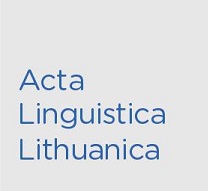Dėl žodžių darybos teorijoje vartojamų terminų ir darybinių elementų klasifikacijos
Regarding the Used Terminology and Classification of Formative Elements in the Theory of Word-Formation
Author(s): Dalius JarmalavičiusSubject(s): Language studies, Morphology, Lexis, Historical Linguistics, Baltic Languages, 17th Century, 18th Century
Published by: Lietuvių Kalbos Institutas
Keywords: vocabulary; noun phrase; derivatives; unique morphemes; afiksoidai;
Summary/Abstract: The analysis of the German nominal compounds in the handwritten Baltic bilingual dictionaries from the 17th–18th shows many problematic aspects: the lack of precise terminology which needs to be corrected in the synchronic theory of word-formation on the one hand and difficulties in the differentiation of decided word-formation patterns on the other hand. In the scientific literature terminology used for the analogous examples of word-formation could be defined as superfluous terminology. This applies in particular to the words with unique morphemes such as in germ. Himmbeere ‘raspberry’, Schornstein ‘chimney’ or lit. šikšnosparnis ‘bat’, titnagas ‘fire stone’. To define the constituents that are demotivated and only occur in individual words, different terms like pseudomorphem, pseudoplerem, Himbeer-morpheme, cranberry-word, cranberry-compounds, cranberry-morphemes etc. are found in the theory of word-formation. It would be more exact to describe such lexical units, using the concept of quasi-compounds with remaining stems (lit. tarsi dūriniai su atliekamais kamienais) suggested by V. Urbutis. However, words with demotivated constituents but with their complex word structure could not be categorized neither as compounds nor as simplex (simple) words, such a definition needs concretization. Taking into account the properties mentioned in this paper, lexical units like germ. Himbeere or lit. titnagas can be defined as complex words with demotivated stems (lit. kompleksinės struktūros žodžiai su nemotyvuotais kamienais). Furthermore, this article discusses the special status of words with the elements that take a position between compound-components and the derivative morphemes and are characterized in the synchronic word-formation as affixoids. It is also difficult to say, if for example, germ. Werck=Tag ‘working day’, Werck=Zeug ‘tool’, Kichen Gutt ‘churches goods’, Hauptmann ‘main person’, Kriegswesen ‘soldier ship’ are compounds or derivations, because we do not have enough clear criteria to differentiate these words. The problem mentioned above is actual in diachronic word-formation, too. In order to determine elements between composition and derivation in historical word-formation one should focus on the following criteria: productivity and their semantic degree of abstraction, their registration as a free lemma in the dictionaries, their ability to change position in words, and word-for word translation of constituents in dictionaries.
Journal: Acta Linguistica Lithuanica
- Issue Year: 2017
- Issue No: 76
- Page Range: 75-88
- Page Count: 14
- Language: Lithuanian

